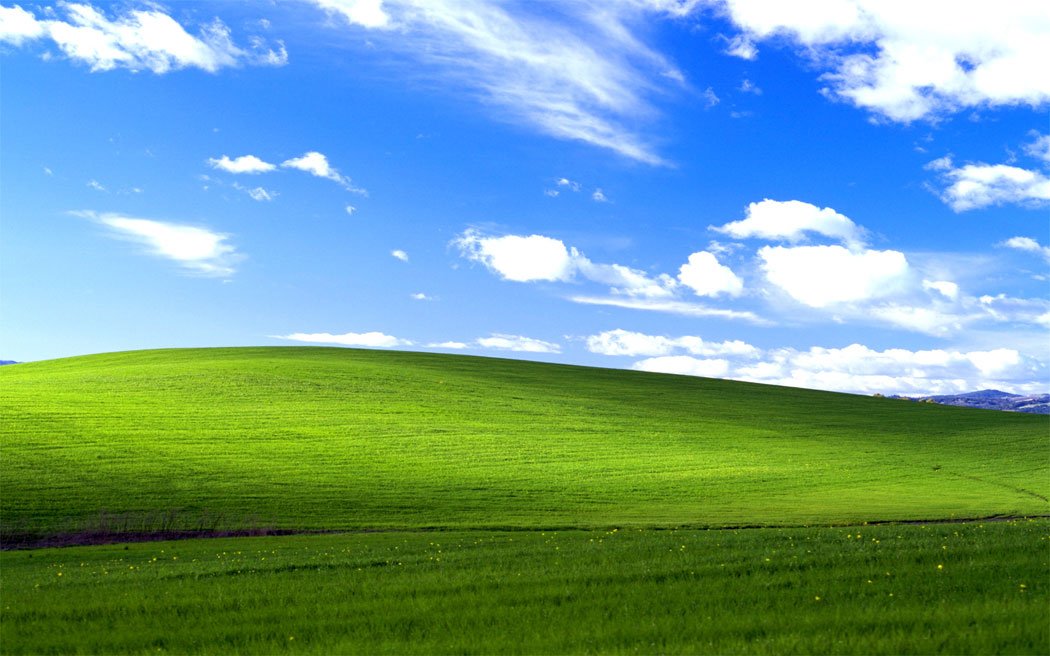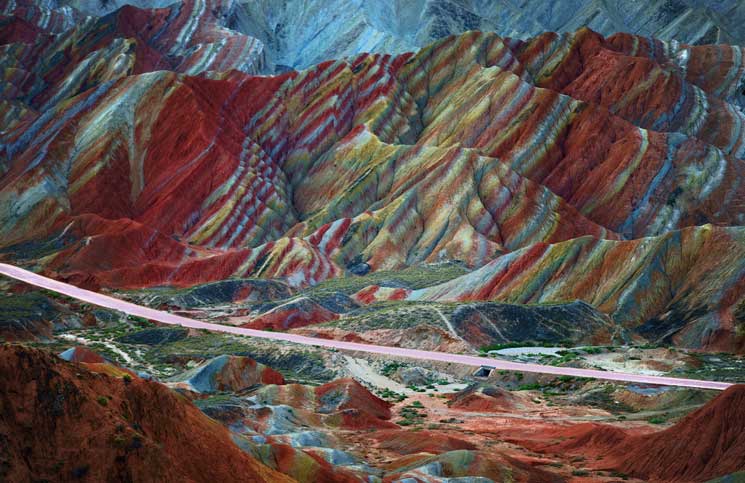We are delighted by colorful displays of fireworks, tickled by the profundity of a psychedelic art exhibit. Even walls of glossy graffiti stop us in our tracks. But, undoubtedly, the most thrilling spectacles of all can be found in nature — and here’s proof, below. Planet earth, you impress us:
Danxia Landform Geological Park, China
 ChinaFotoPress via Getty Images
ChinaFotoPress via Getty ImagesThis mountain range appears to be Dr. Seuss inspired. The trippy landscape (yes, it’s natural) are part of the Zhangye Danxia Landform Geological Park in China.
Tulip Fields, Northern Netherlands
 AP Photo/Peter Dejong
AP Photo/Peter DejongThis is not a close-up of a patchwork rug, but an aerial view of tulip fields in northern Netherlands.
Red Beach, Panjin, China
 AFP/AFP/GettyImages
AFP/AFP/GettyImagesChina’s “Red Beach” gets its vibrant hue from a particular kind of seaweed that transforms from green to crimson in the fall. The Sueda species is one of the only kinds of seaweed that tolerates a highly-alkaline soil.
Bark Of A Rainbow Eucalyptus In Wailua, Hawaii
 Christopher Martin Photography
Christopher Martin PhotographyThis is a tree. The Eucalyptus deglupta is the Gobstopper of trees: Its flaky bark sheds to reveal a rainbow of colors. Believe it or not, it’s the only species of eucalyptus found naturally in the northern hemisphere.
Flower Petal Eruption, Costa Rica
No, this didn’t happen without man’s intervention; the rainbow petal explosion was part of a shoot captured by photographer Nick Meek for a Sony campaign. Even still, the striking scene, which called for 3.5 tons of vibrant flower petals, outshines anything you might find on a Pantone sample swatch. (Courtesy McCann)
Blue Ridge Mountain, Virginia
 Getty Images
Getty ImagesPart of the Appalachian Mountain range, The Blue Ridge Mountains stretch across the eastern U.S., from Georgia to Pennsylvania. This photo was taken from Skyline Drive in Shenandoah National Park.
Grand Prismatic Spring, Yellowstone Park, Wyoming
 AP Photo/Harry N. Abrams, Inc., Yann Arthus-Bertrand
AP Photo/Harry N. Abrams, Inc., Yann Arthus-BertrandThis mystical pool is actually the largest hot spring in the United States. Why does it look like a rainbow? A combination of pigmented bacteria and light refraction make for quite the scene and change depending on season, air temperature and the sun’s visibility.
Ayers Rock, Australia
 Mark Kolbe/Getty Images
Mark Kolbe/Getty ImagesThis vibrant and vast sandstone formation, also known as Uluru, is a striking contrast to another one of Australia’s natural wonders:The Great Barrier Reef. The rock is massive — it has a circumference of about 9,400 meters and the trek to the top is about 1,600 meters.
Not Just A Microsoft Desktop Wallpaper, San Francisco
 Microsoft
MicrosoftIf this picture looks familiar, it’s because it might have been your desktop wallpaper at one point during the early 00s. Though it appears, perhaps, too serene to exist in reality, Microsoft claims the appropriately named “Bliss” image is the real deal. Even on the endless travel that is the World Wide Web, nature prevails.
Canola Flower Fields, Yunnan, China
 Katie Garrod via Getty Images
Katie Garrod via Getty ImagesIt is no wonder China’s canola flower fields are often referred to as a “golden sea.” The sunshine party is in full blossom from February through March.
Hitachi Seaside Park, Ibaraki, Japan
 flickr/shin–k
flickr/shin–kThis enormous Japanese park, which spans nearly 470 acres, hosts a plethora of breathtaking fauna, including the kochia shrubs pictured. It’s a breeding ground for flower paradise. By October, these 36,000 bulbous plants molt from green to red.
Lavender Field, Valensole, France
Lavender is not specific to France, but the potent plant makes for a whimsical scene in the already-enchanting countryside.
Yuanyang County, Yunnan, China
This is an aerial shot of terraced rice paddies in Yuanyang county. The landscape gets it textured shape from the varying mountain ranges and slope degrees.
Pamukkale Hot Springs, Denizli Province, Turkey
 Brian Hammonds via Getty Images
Brian Hammonds via Getty ImagesPamukkale translates to “cotton castle.” The crystal pools are encased by the natural cotton-colored edges — called travertines — from carbonate minerals formed by the flowing waters.
Lake Retba, Senegal
 Lake Retba looks sweet, but it is salt that gives the astonishing body of water its cotton candy hue. Senegal’s vibrant lake changes hues all year long, and is brightest during dry season.
Lake Retba looks sweet, but it is salt that gives the astonishing body of water its cotton candy hue. Senegal’s vibrant lake changes hues all year long, and is brightest during dry season.
Lake Hillier, Western Australia
 Another pinky wonder, the nearly 2,000-foot long lake sits on Middle Island, an islet that makes up the Recherche Archipelago in Western Australia.
Another pinky wonder, the nearly 2,000-foot long lake sits on Middle Island, an islet that makes up the Recherche Archipelago in Western Australia.
Wooden Shoe Tulip Farm, Woodburn, Oregon

Rows and rows of enticing tulips line this charming Oregon farm; they are in full, blossoming glory in the spring time.
Great Blue Hole, Belize
 Marine conservationist Jacques Cousteau and his team of divers made an expedition to the sink hole in the early 1970s to chart its depth. While measurements have differed since his dive, the hole is estimated to be over 400 feet deep, and is a treasured spot for scuba divers around the world. estimated to be over 400-feet deep, and is a treasured spot for scuba divers around the world.
Marine conservationist Jacques Cousteau and his team of divers made an expedition to the sink hole in the early 1970s to chart its depth. While measurements have differed since his dive, the hole is estimated to be over 400 feet deep, and is a treasured spot for scuba divers around the world. estimated to be over 400-feet deep, and is a treasured spot for scuba divers around the world.
Valley Of Flowers National Park, Uttarakhand, India
 This flower-filled park bursts to the brim with diverse flora and a stunning mountain range. The space stretches some 175 acres.
This flower-filled park bursts to the brim with diverse flora and a stunning mountain range. The space stretches some 175 acres.
Caño Cristales River, Meta, Columbia

“The river of five colors” gets its “liquid rainbow” appearance from Macarenia clavigera — a plant that lines the river’s floor and turns red between Colombia’s wet and dry seasons. When the water level gets low enough, the incredible colors are most visible.
Hills Of The Palouse Grasslands, Washington State
 The sun’s interaction with the Palouse, a northwestern region of the United States, makes for picturesque pockets of gold.
The sun’s interaction with the Palouse, a northwestern region of the United States, makes for picturesque pockets of gold.
The Wave in Paria Canyon, Arizona
 This sandstone rock is called “The Wave,” for its standout, rhythmic patterns formed by erosion. The site is part of the Vermillion Cliffs, a 112,500 acre region based in both Arizona and Utah.
This sandstone rock is called “The Wave,” for its standout, rhythmic patterns formed by erosion. The site is part of the Vermillion Cliffs, a 112,500 acre region based in both Arizona and Utah.
 ChinaFotoPress via Getty Images
ChinaFotoPress via Getty Images AP Photo/Peter Dejong
AP Photo/Peter Dejong AFP/AFP/GettyImages
AFP/AFP/GettyImages Christopher Martin Photography
Christopher Martin Photography
 Getty Images
Getty Images AP Photo/Harry N. Abrams, Inc., Yann Arthus-Bertrand
AP Photo/Harry N. Abrams, Inc., Yann Arthus-Bertrand Mark Kolbe/Getty Images
Mark Kolbe/Getty Images Microsoft
Microsoft Katie Garrod via Getty Images
Katie Garrod via Getty Images flickr/shin–k
flickr/shin–k

 Brian Hammonds via Getty Images
Brian Hammonds via Getty Images Lake Retba looks sweet, but it is salt that gives the astonishing body of water its cotton candy hue. Senegal’s vibrant lake changes hues all year long, and is brightest during dry season.
Lake Retba looks sweet, but it is salt that gives the astonishing body of water its cotton candy hue. Senegal’s vibrant lake changes hues all year long, and is brightest during dry season.  Another pinky wonder, the nearly 2,000-foot long lake sits on Middle Island, an islet that makes up the Recherche Archipelago in Western Australia.
Another pinky wonder, the nearly 2,000-foot long lake sits on Middle Island, an islet that makes up the Recherche Archipelago in Western Australia. 
 Marine conservationist Jacques Cousteau and his team of divers made an expedition to the sink hole in the early 1970s to chart its depth. While measurements have differed since his dive, the hole is estimated to be over 400 feet deep, and is a treasured spot for scuba divers around the world. estimated to be over 400-feet deep, and is a treasured spot for scuba divers around the world.
Marine conservationist Jacques Cousteau and his team of divers made an expedition to the sink hole in the early 1970s to chart its depth. While measurements have differed since his dive, the hole is estimated to be over 400 feet deep, and is a treasured spot for scuba divers around the world. estimated to be over 400-feet deep, and is a treasured spot for scuba divers around the world.  This flower-filled park bursts to the brim with diverse flora and a stunning mountain range. The space stretches some 175 acres.
This flower-filled park bursts to the brim with diverse flora and a stunning mountain range. The space stretches some 175 acres. 
 The sun’s interaction with the Palouse, a northwestern region of the United States, makes for picturesque pockets of gold.
The sun’s interaction with the Palouse, a northwestern region of the United States, makes for picturesque pockets of gold.  This sandstone rock is called “The Wave,” for its standout, rhythmic patterns formed by erosion. The site is part of the Vermillion Cliffs, a 112,500 acre region based in both Arizona and Utah.
This sandstone rock is called “The Wave,” for its standout, rhythmic patterns formed by erosion. The site is part of the Vermillion Cliffs, a 112,500 acre region based in both Arizona and Utah.
















